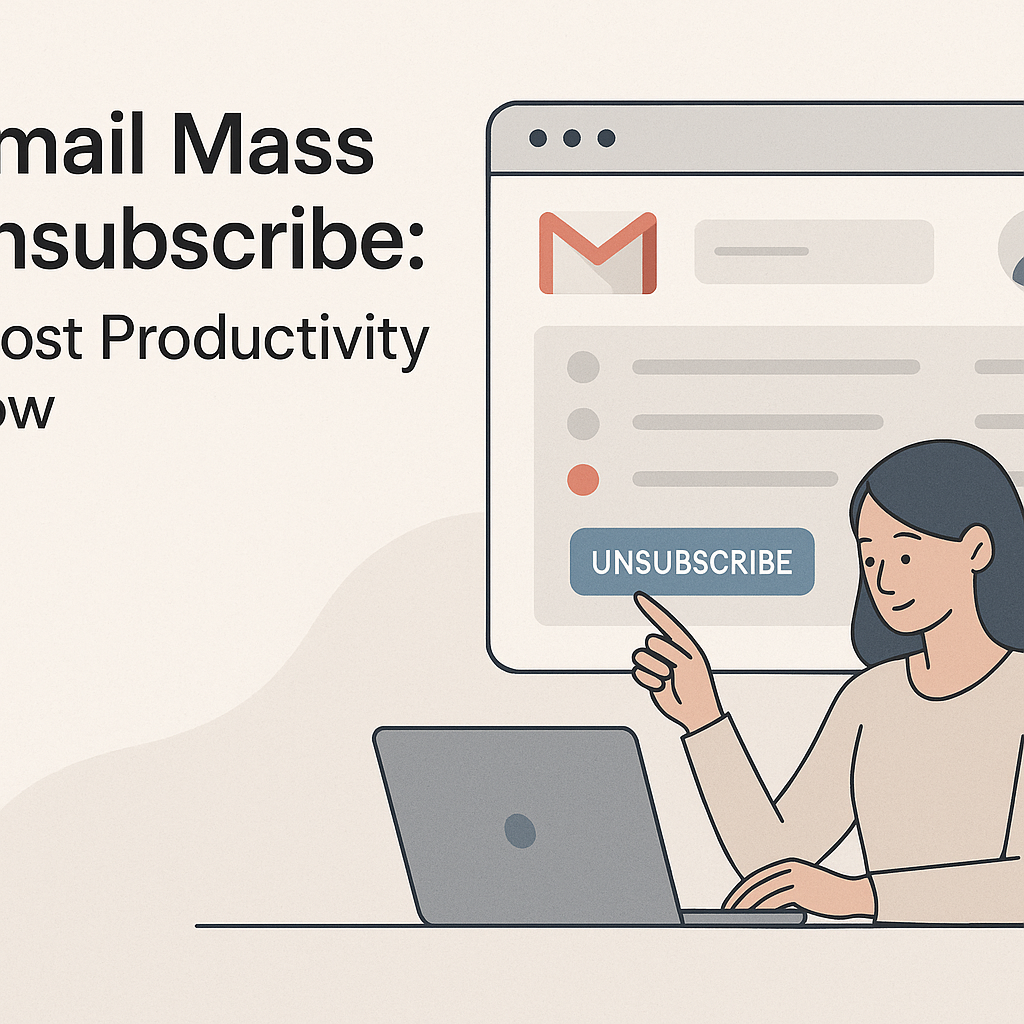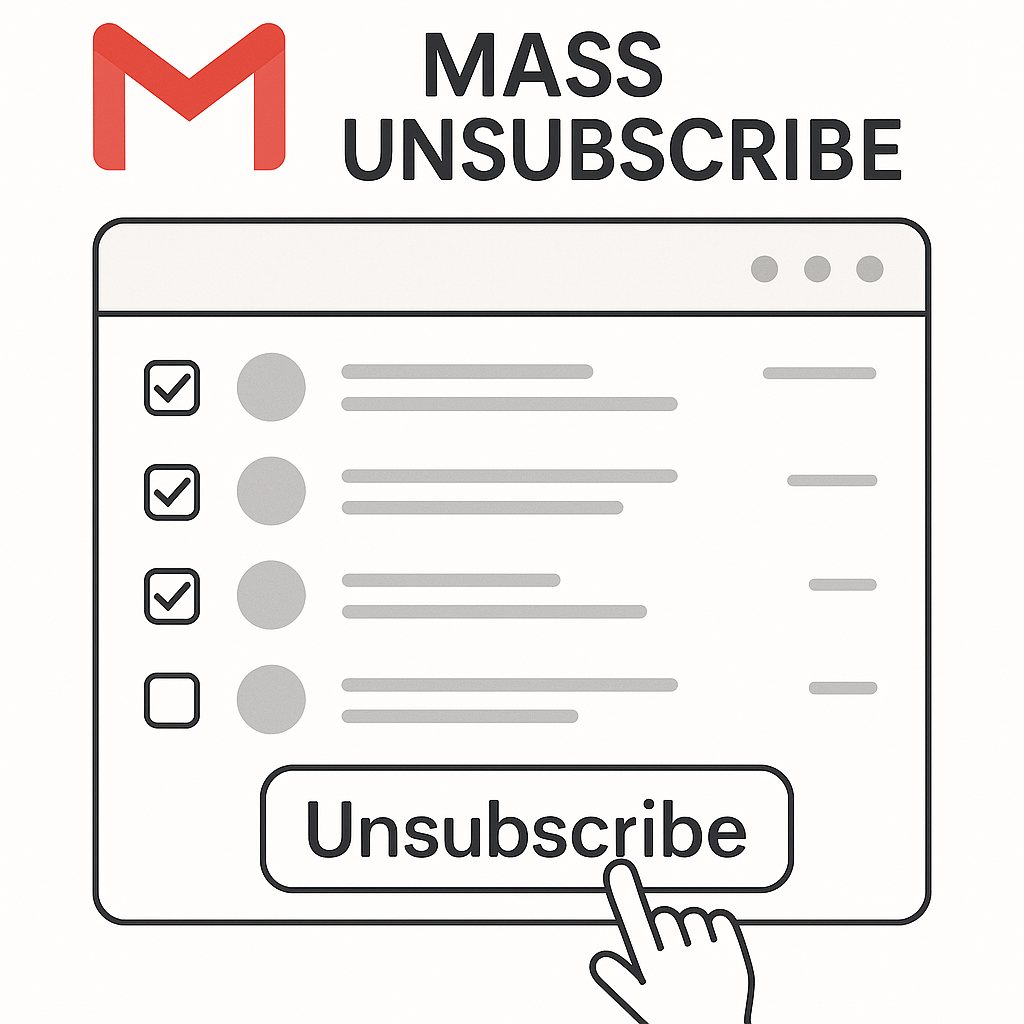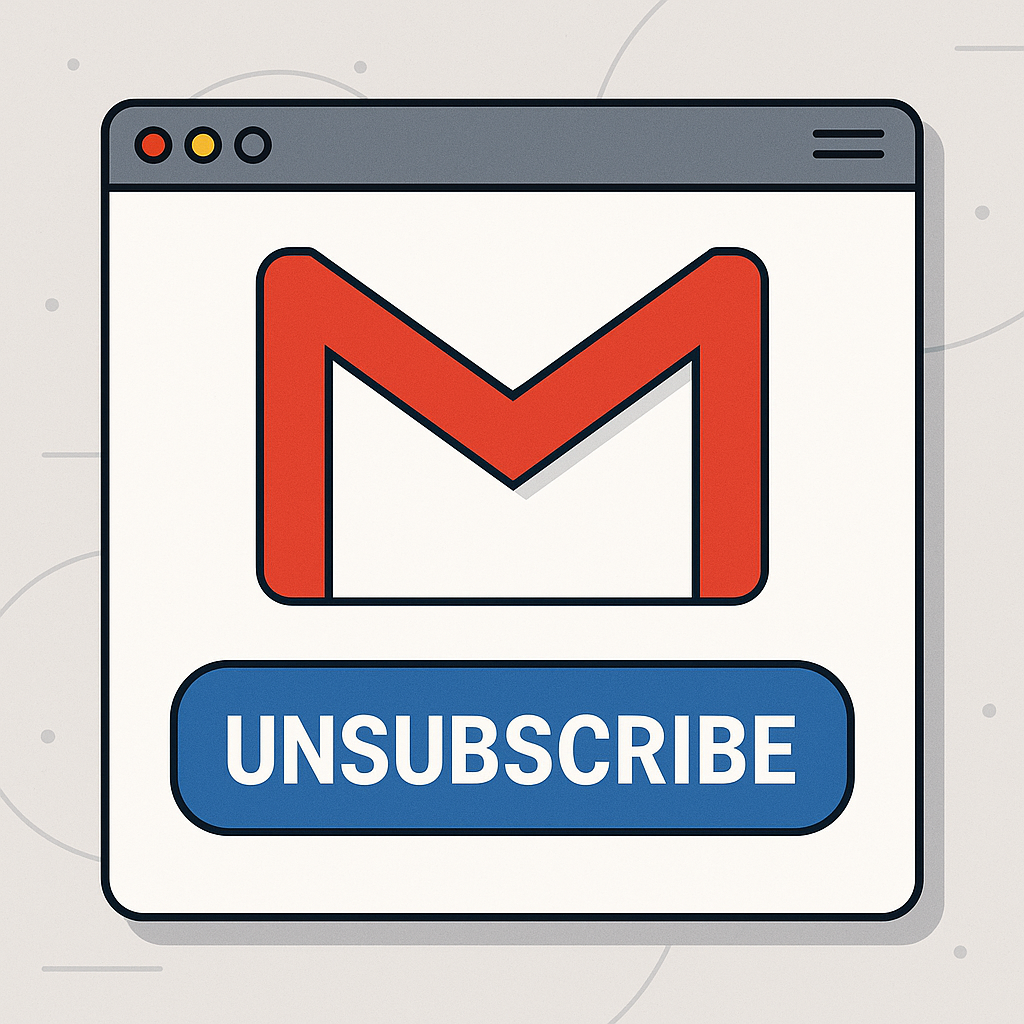Gmail Mass Unsubscribe: Boost Productivity Now

Is your Gmail inbox a black hole of newsletters, promotional offers, and notifications you vaguely remember signing up for? You're not alone. For business professionals, entrepreneurs, and marketing teams, an overflowing inbox isn't just an annoyance; it's a significant drain on productivity, focus, and mental energy. Every unread email is a tiny demand on your attention, pulling you away from critical tasks, client communication, and strategic thinking. The solution? Mastering the art of gmail mass unsubscribe.
In today's digital-first world, managing email effectively is paramount to success. An unmanageable inbox can lead to missed opportunities, increased stress, and a general feeling of being overwhelmed. This article will guide you through effective strategies to declutter your Gmail, reclaim your time, and significantly boost your overall email productivity. We'll explore how to tackle those endless subscription emails, leveraging both Gmail's built-in capabilities and the power of modern tools.
Understanding the Problem: The Overwhelmed Inbox
The modern professional is bombarded with an average of 120 emails per day. While many of these are legitimate business communications, a significant portion often consists of subscriptions that have outlived their usefulness or were never truly needed. These unwanted emails contribute to:
- Information Overload: Drowning in promotional content makes it harder to find important messages.
- Decreased Focus: Constant notifications and the sheer volume of unread emails fragment attention spans.
- Wasted Time: Sorting through junk mail, even just to delete it, consumes valuable minutes that could be spent on revenue-generating activities. Studies suggest professionals spend as much as 20% of their workweek managing email.
- Increased Stress: The visual clutter of a full inbox can create a sense of anxiety and disorganization, impacting mental well-being.
- Missed Opportunities: Critical client emails or urgent requests can get buried beneath a mountain of irrelevant messages.
For sales and marketing teams, this clutter can be particularly detrimental. It's not just about personal inbox management; it's about ensuring that vital outreach and client communication aren't lost. Effectively managing your subscriptions is a key component of efficient email list management and maintaining a professional edge.
Manual Unsubscribe Methods in Gmail: Step-by-Step Guide
The most straightforward, albeit time-consuming, method to unsubscribe from emails is the manual approach. Every legitimate sender is required to provide an unsubscribe link, typically found at the very bottom of their emails.
Here’s how to do it manually:
- Open the Email: Locate an email from a sender you no longer wish to receive messages from.
- Scroll to the Bottom: Navigate to the footer of the email. Look for phrases like "Unsubscribe," "Manage Preferences," "Update Subscription," or similar.
- Click the Link: Click on the unsubscribe link. This will usually open a new tab or window in your browser.
- Confirm Unsubscription: Follow the on-screen prompts. Some services require you to confirm your decision, while others may ask for feedback.
- Repeat for Each Email: Unfortunately, this process must be repeated for every sender you want to opt out of.
While this method is effective for individual emails, it becomes impractical when you're facing hundreds or thousands of unwanted subscriptions. The sheer volume makes this approach inefficient for anyone serious about regaining control of their inbox.
Identifying Subscription Patterns to Reduce Clutter
Before you dive headfirst into unsubscribing, take a moment to understand where most of the clutter is coming from. Identifying patterns can help you make more strategic decisions about your subscriptions and prevent future inbox overload.
Consider these common sources and strategies:
- Newsletters: Are you subscribed to multiple industry newsletters? Are they still providing value? Perhaps you can consolidate or unsubscribe from those that are no longer relevant.
- Promotional Emails: Retailers, service providers, and brands often send marketing campaigns. Be selective about which companies you allow to market to you.
- Notifications: Social media updates, forum activity, or online service alerts can flood your inbox. Adjust notification settings directly within those platforms or services.
- Webinar/Event Invitations: While useful, these can pile up if not managed.
- Sign-up Habits: Think back to when you signed up for these lists. Did you provide your primary email for a one-time download or offer?
Actionable Tip: Use Gmail's search functionality. Search for terms like "unsubscribe," "manage preferences," or use specific sender addresses you suspect are the main culprits (e.g., from:[email protected]). This can help you group similar emails and tackle them more efficiently.
Leveraging Gmail's Built-in Features for Unsubscribing
Gmail itself offers some handy features to help you manage inbox clutter, especially for bulk unsubscribing.
Gmail's Unsubscribe Prompt
For many emails, especially those from legitimate marketing lists, Gmail automatically detects the unsubscribe link and displays a prominent "Unsubscribe" button at the top of the email, right next to the sender's address. This is Gmail’s way of simplifying the process. Clicking this button triggers the unsubscribe process without you needing to scroll through the email body.
Using Search and Filters
While Gmail doesn't have a dedicated "mass unsubscribe" button, you can use its powerful search operators to find and manage emails in bulk. This is a more advanced method but can be very effective.
Steps to use search for unsubscribing:
- Search for Senders: In the Gmail search bar, type
from:[email protected]. - Select All: Once the search results appear, click the checkbox at the top to select all conversations. If you have more than one page of results, a prompt will appear asking if you want to "Select all conversations that match this search." Click that.
- Take Action: With all relevant emails selected, you can now choose to:
- Delete: Click the trash icon to remove them all at once.
- Archive: Click the archive icon to remove them from your inbox view, keeping them accessible if needed.
- Mark as Read/Unread: Less relevant for unsubscribing but useful for other cleanup tasks.
Advanced Search for Unsubscribe Links: You can also search for emails that are likely to have unsubscribe links by using terms like unsubscribe OR "manage preferences" OR "update subscription" in conjunction with sender filters. For example: from:[email protected] (unsubscribe OR "manage preferences").
While this helps in bulk deleting or archiving, it doesn't *actually* unsubscribe you from the sender's list. For true unsubscribing, you still need to click the link. However, combining search with Gmail's top "Unsubscribe" prompt (when available) can speed things up considerably.
When to Use Third-Party Unsubscribe Tools
When Gmail’s built-in features aren't enough, and manual unsubscribing is too tedious, third-party tools and browser extensions become invaluable. These tools are specifically designed to streamline the process of unsubscribing from multiple email lists efficiently.
Benefits of Third-Party Tools:
- Bulk Unsubscribe: Many tools can scan your inbox, identify subscription emails, and allow you to unsubscribe from dozens or hundreds of lists with just a few clicks.
- Automated Scanning: They often automatically detect mailing lists and present them in an organized dashboard.
- One-Click Unsubscribe: They simplify the process, often handling the backend actions required to remove you from lists.
- Safety and Security: Reputable tools are designed with privacy in mind, often using your Gmail API access securely to perform actions on your behalf.
Examples of such tools, often available as browser extensions or web applications, include services that offer features like mass deletion of emails, grouping newsletters, and unblocking senders. These can significantly improve your email productivity by automating repetitive tasks. You can find many such options on the Google Workspace Marketplace or as browser extensions. Some are even designed to help you manage your inbox more effectively, offering features beyond just unsubscribing.
AI-Powered Solutions for Effortless Email List Management
The most advanced and efficient way to tackle email overwhelm and manage subscriptions is by leveraging Artificial Intelligence. AI-powered email tools go beyond simple automation; they learn your habits, prioritize your communications, and can proactively manage your inbox to maintain a clean and productive state.
AI tools can:
- Intelligently Identify Subscriptions: AI algorithms can recognize patterns in emails that indicate subscriptions, even if they don't have a standard unsubscribe link.
- Automate Unsubscribe Requests: They can initiate the unsubscribe process automatically, saving you from manual clicking or even interacting with sender websites.
- Categorize and Prioritize: Beyond unsubscribing, AI can sort incoming mail into categories (e.g., important, promotional, social) and flag urgent messages, ensuring you see what matters most first.
- Learn Your Preferences: Over time, AI can learn which types of emails you interact with and which you consistently ignore, refining its management strategies.
For those seeking advanced automation and a truly streamlined inbox experience, consider leveraging tools like an ai executive assistant. These platforms can intelligently identify and manage subscriptions, sort incoming mail, and ensure you focus on what matters most. By integrating with your email, an AI email tools platform can act as a powerful ally in your quest for inbox efficiency, helping you master your inbox.
These intelligent solutions are part of a broader trend where AI is transforming how professionals manage their workflows. For instance, AI for sales prospecting uses similar intelligent capabilities to identify leads and tailor outreach, demonstrating the power of AI in business productivity.
Best Practices for Maintaining a Clutter-Free Inbox
Unsubscribing is a great start, but maintaining a clean inbox requires ongoing habits and strategies. Think of it like decluttering your physical workspace – regular tidying prevents chaos from returning.
Here are some best practices:
- Be Selective About New Subscriptions: Before entering your email address on a new website, ask yourself if you truly need to receive ongoing communications from them. Consider using a secondary email address for less critical sign-ups.
- Unsubscribe Immediately: When you receive an email you don't want, take the 30 seconds to unsubscribe right away. Don't let it pile up.
- Utilize Gmail Filters and Labels: Create filters to automatically label, archive, or even delete emails from specific senders or with certain keywords. This is especially useful for notifications or less important newsletters you might want to read later.
- Schedule Regular Inbox Cleanup: Dedicate 10-15 minutes each week to review your inbox, unsubscribe from unwanted lists, and archive or delete old messages.
- Use Email Aliases: Services like Gmail allow you to create aliases (e.g., [email protected]). This can help you track where your email address is being used and filter emails sent to specific aliases.
- Embrace the "Inbox Zero" Philosophy: While not strictly about unsubscribing, the goal of Inbox Zero is to process your email efficiently so that your inbox is empty or contains only actionable items. Regular unsubscribing is a key step towards this goal.
- Review Your Existing Subscriptions Periodically: Set a reminder every few months to do a larger purge of subscriptions you've forgotten about or no longer find valuable.
Maintaining a clean inbox is an ongoing process, much like managing your overall workflow. For professionals looking to optimize their operations, understanding how to master work email is crucial, and this includes proactive subscription management.
Reclaiming Productivity: The Benefits of a Clean Inbox
The effort invested in a gmail mass unsubscribe strategy and maintaining a clean inbox pays significant dividends. By reducing digital noise and eliminating distractions, you unlock a host of productivity benefits:
- Improved Focus and Concentration: With fewer irrelevant emails vying for your attention, you can concentrate better on high-priority tasks, leading to higher quality work.
- Significant Time Savings: Less time spent sorting, deleting, or being distracted by unwanted emails translates directly into more time for productive activities.
- Reduced Stress and Mental Clutter: A tidy inbox contributes to a clearer mind, reducing feelings of overwhelm and anxiety associated with information overload.
- Enhanced Decision-Making: When important emails aren't buried, you can respond faster to opportunities and critical communications, leading to better business decisions.
- Better Organization: A clean inbox is a hallmark of an organized professional. It reflects a systematic approach to managing information and responsibilities.
In a competitive business landscape, staying ahead means prioritizing strategic communications and filtering out noise. Similarly, mastering your inbox by unsubscribing from non-essential emails allows you to focus on critical messages that drive growth and decision-making, much like how businesses analyze competitor strategies to refine their own. It's about working smarter, not harder.
Ready to take back control of your Gmail inbox and boost your productivity? Start by identifying your most frequent senders and systematically unsubscribing. Explore Gmail’s built-in features, consider third-party tools, and look into AI-powered solutions to automate the process. Your future, more productive self will thank you.



